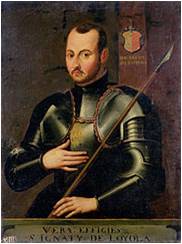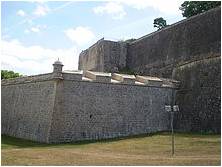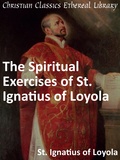Introduction

This summer in Christian Devotional Classics (Evangelical Seminary), I presented on Saint Ignatius of Loyola (1491 – 1556) and the Spiritual Exercises (1522 to 1524). Considering the importance of the Society of Jesus in higher education, future posts are already in concept — if this is a project of interest, please email me.
In the first part of this post is a rough timeline of a Spanish knight who became a mystical “Soldier for Christ” pioneering an educational, missional, and spiritual Counter-Reformation. In the second part one finds a week of reflections on “What Saint Ignatius of Loyola and the Spiritual Exercises have to say to us today.”
Saint Ignatius of Loyola (1491 – 1556)
Biography: Before Christ
In coming to Christ he had visions of Jesus and Mary and offered all to God becoming . . .

Historical & Theological Context: A time of conquest across Europe, the Church, the globe, and within . . .
The Counter-Reformation: Embodied in the Society of Jesus (Jesuits)
What does Saint Ignatius of Loyola (1491 – 1556) have to say to us today?

Daily Reflections for the course of the week from which you pick up this post. The material is drawn from drafts I posted on the Emerging Scholars Network Facebook Wall as part of a class on Christian Devotional Classics at Evangelical Seminary. Click here for a free copy of Spiritual Exercises via the Christian Classics Ethereal Library. Please email me if you use the second section to stimulate campus discussion (e.g., brown bag lunch discussion group). I am particularly interested in suggestions on revisions for use in that context.
1. What books/stories frame your life and our larger culture? Ignatius of Loyola (1491 – 1556) was a Spanish knight from a Basque noble family with a “Love of martial exercises and a vainglorious desire for fame.” He read about and desired to be like El Cid, the knights of Camelot, etc. But in the Battle of Pampeluna (1521), he suffered a leg wound and was lamed by a French cannonball. Medical care was little more than convalescence (1521). The only reading options he had while recovering for a year were about Christ and the saints (Ludolf of Saxony’s Life of Christ and James of Vorgine’s Golden Legend). His life was transformed, with God speaking to him in dynamic ways in the following years. As a result he became a “Soldier for Christ” (Eph. 6.10-17), later founding an order (The Society of Jesus, also known as the Jesuits) with such a vision.
For Deeper Reflection: What do you think about the image of being a “Soldier for Christ”? Are you comfortable with it?
2. What has been your educational journey? By what is it inspired? In what direction is it headed, toward what end?
Although Ignatius of Loyola grew up in a Basque noble family, they did not have the wealth for him to receive a strong education in his younger years. Furthermore, during his teen years he sought be like El Cid (or the knights of Camelot) instead of entering the university.
When he came to campus with a call from God to become a priest, Ignatius of Loyola had a lot of catch-up to do. Despite his struggles, he pressed on in finishing the Spiritual Exercises, birthed by his interactions with God during his convalescence (1521). In addition to refining his writing skills, Ignatius of Loyola’s gifts of articulation were sharpened in his university years by defending himself in the face of the Inquisition multiple times.
Later in life, Ignatius of Loyola had the opportunity to see his vision for educational outreach to stretch even beyond Europe through the tight small group which founded The Society of Jesus. Note: 74 Jesuit colleges were founded by Ignatius’ death. At present there are 3,730 Jesuit educational institutions throughout the world, caring for just over 2.5 million students. To learn about Jesuit education click here and here (United States). Yes, I’m finding this a fascinating story and desire to research it further.
3. “SPIRITUAL EXERCISES whereby to conquer oneself, and order one’s life, without being influenced in one’s decision by any inordinate affection.” — Ignatius of Loyola. Spiritual Exercises.
For Deeper Reflection: Do you desire to conquer yourself? Do you think it is possible? What is God’s role in relationship to such an endeavor, to your daily life? Ignatius of Loyola out of his own encounter(s) with God, wrote the Spiritual Exercises to guide spiritual directors as they led directees in month long retreats.
In your free time I encourage you to take a few minutes to review Spiritual Exercises and ask whether or not you are open to such a routine for “re-calibration.” Taking a step back, in what manner do you think Ignatius of Loyola’s military background influenced the Spiritual Exercises helpfully/unhelpfully? Would you be willing to enter an “Order” such as the Society of Jesus to follow Jesus . . . to serve as a missional educator (see 2)? What are Protestant equivalents in passion, discipline, and a sense of mission?
4. Ignatius of Loyola through a significant battle injury (Battle of Pamplona, Spain, 1521), extended time of recovery filled with “day-dreaming,” spiritual reading, several near death experiences, and a number of visions received a “dramatic call” to follow God and enter ministry.
For Deeper Reflection: Have you received a “dramatic call” to your vocation (Note: Does not need to be “ministry,” could be to business, health care, higher ed, science . . .)? If so, how do you share this call with others? Do you have a friend (or friends) who received a “dramatic call” to their vocation? If so, how do you respond when their “story” is shared?
Related: At “Flourishing in the Academy,” the national gathering of the Emerging Scholars Network at Following Christ 2008, Marc Baer of Hope College addressed the question “What is Calling?” The text of his message is available here.
5. What makes good writing? Why do so many desire to read “the original text” of major historical figures? Louis Dupre & James A. Wiseman’s brief biography of Ignatius of Loyola in Light from Light: An Anthology of Christian Mysticism begins:
“Only in recent years have we witnessed serious efforts to restore Ignatius to the place of honor he deserves in the development of Western mysticism. Formerly the man tended to disappear behind his formidable accomplishment: the inspiration and organization of that most versatile of all religious orders, the Society of Jesus, with its legions of saints, scholars, spiritual directors, teachers, and missionaries. Often the spiritual writings of this poor stylist were eclipsed by those of his more eloquent followers. Ignatius wrote little and, we confess, badly. Moreover, he succeeded in destroying all but one small part of his diaries. Still we may justifiably claim that his mystical vision stands at the origin of one of the greatest outbursts of spiritual energy in the history of the Catholic Church” (284).
Ignatius of Loyola spent a lifetime revising his Spiritual Exercises in order for them to be of the greatest benefit. Unlike John Calvin’s Institutes of the Christian Religion, which also underwent a lifetime of revisions, Ignatius’ “handbook” received much revision by those who continued the work of their founder. In more recent years there has been a desire to peel back the layers of revisions, to truly connect with the great passion/call of this “soldier for Christ.” Instead of comparing Ignatius of Loyola’s work with the scholastics or the poetry of mystics such as St. John of the Cross, it is good to receive these few simple, guiding words from an inspirational “contemplative in action” . . . applying them in their and to our missional/devotional context.
6. What would you think about having your spiritual diary (if you keep one) published? What is the difference between the “window” on the life of a “saint” provided by selections from a spiritual diary and an autobiography?
In Louis Dupre & James A. Wiseman’s Light from Light: An Anthology of Christian Mysticism, I read excerpts of both from Ignatius of Loyola. Personally, I’m not surprised that Ignatius of Loyola attempted to destroy his spiritual diary and others, such as Brother Lawrence, asked that their letters never be shared with others. At times these communications are truly private matters. Yes, they give historians, teachers, and Christians great insights, but as taking pictures during special moments, some things are too sacred. Is it possible for us to restrain ourselves in an “open” age of sharing such as ours?
7. “. . . God treated him at this time [1522, at Manresa] just as a schoolmaster treats a child whom he is teaching. Whether this was because of his lack of education and of brains, or because he had no one to teach him, or because of the strong desire God himself had given him to serve him, he believed without doubt, and has always believed that God treated him in this way. Indeed if he were to doubt this, he would think he offended his Divine Majesty. . . .” — Ignatius of Loyola. Autobiography*
For Deeper Reflection: The above selection from Ignatius of Loyola’s “Autobiography” embodies his relationship with God. What do you think about this metaphor for God — as you reflect upon being a student, possibly a teacher, possibly even a participant/founder of a mission (national/international) with an educational focus?
How about this as an example of Ignatius of Loyola being instructed by the “schoolmaster,” “Once he was going out of devotion to a church situated a little more than a mile from Manresa; I believe it is called St. Paul’s, and the road goes by the river. As he went along occupied with his devotions, he sat down for a little while with his face toward the river, which ran down below. While he was seated there, the eyes of his understanding began to be opened; not that he saw any vision, but he understood and learnt many things, both spiritual matters and matters of faith and of scholarship, and this with so great an enlightenment that everything seemed new to him. The details that he understood then, though they were many, cannot be stated, but only that he experienced a great clarity in his understanding. This was such that in the whole course of his life, after completing sixty-two years, even if he gathered up all the various helps he many have had from God and all the various things he has known, even adding them all together, he does not think he had got as much as at that one time”.**
* Dupre, Louis & James A. Wiseman, eds. Light from Light: An Anthology of Christian Mysticism. Paulist Press, 2010. p.289.
**Ibid, 290-291.
Tom enjoys daily conversations regarding living out the Biblical Story with his wife Theresa and their four girls, around the block, at Elizabethtown Brethren in Christ Church (where he teaches adult electives and co-leads a small group), among healthcare professionals as the Northeast Regional Director for the Christian Medical & Dental Associations (CMDA), and in higher ed as a volunteer with the Emerging Scholars Network (ESN). For a number of years, the Christian Medical Society / CMDA at Penn State College of Medicine was the hub of his ministry with CMDA. Note: Tom served with InterVarsity Christian Fellowship / USA for 20+ years, including 6+ years as the Associate Director of ESN. He has written for the ESN blog from its launch in August 2008. He has studied Biology (B.S.), Higher Education (M.A.), Spiritual Direction (Certificate), Spiritual Formation (M.A.R.), Ministry to Emerging Generations (D.Min.). To God be the glory!

We notice a certain progression in Ignatius’ dealing with accusations against him. The first time he allowed them to cease without any pronouncement being given in his favour. The second time he demurred at Figueroa wanting to end in this fashion. The third time, after sentence had been passed, he appealed to the Archbishop of Toledo against some of its clauses. Finally he does not await sentence , but goes at once to the judge to urge an inquiry, and eventually he made it his practice to demand sentence , whenever reflection was cast upon his orthodoxy . (Records of Ignatius’ legal proceedings at Azpeitia, in 1515; at Alcal´ in 1526, 1527; at Venice , 1537; at Rome in 1538, will be found in “Scripta de S. Ignatio”, pp. 580-620.) Ignatius had now for the third time gathered companions around him. His first followers in Spain had persevered for a time, even amid the severe trials of imprisonment , but instead of following Ignatius to Paris , as they had agreed to do, they gave him up. In Paris too the first to follow did not persevere long, but of the third band not one deserted him. They were (St.) Peter Faber , a Genevan Savoyard ; (St.) Francis Xavier , of Navarre ; James Laynez , Alonso Salmerón , and Nicolás Bobadilla , Spaniards ; Simón RodrÃguez, a Portuguese . Three others joined soon after — Claude Le Jay, a Genevan Savoyard ; Jean Codure and Paschase Broët, French. Progress is to be noted in the way Ignatius trained his companions. The first were exercised in the same severe exterior mortifications , begging, fasting , going barefoot, etc., which the saint was himself practising. But though this discipline had prospered in a quiet country place like Manresa, it had attracted an objectionable amount of criticism at the University of Alcalá . At Paris dress and habits were adapted to the life in great towns; fasting , etc., was reduced; studies and spiritual exercises were multiplied, and alms funded.